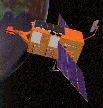|
|
The Rossi X-ray Timing Explorer

The Rossi X-ray Timing Explorer, RXTE, was
launched on
December 30, 1995. RXTE was designed to facilitate the study of time
variability in the emission of X-ray sources with moderate spectral
resolution. Time scales from microseconds to months are covered in a
broad spectral range from 2 to 250 keV. It was designed for a required
lifetime of two years, but operated for more than 16 years.
Mission Characteristics
 Lifetime : 30 December 1995 to 05 January 2012
Lifetime : 30 December 1995 to 05 January 2012
 Energy Range : 2 - 250 keV
Energy Range : 2 - 250 keV
 Special Features : Very large collecting area and all-sky
monitoring of bright sources
Special Features : Very large collecting area and all-sky
monitoring of bright sources
 Payload :
Payload :
- Proportional Counter Array (PCA)
2-60 keV energy range, 6500 sq cm, time resolution 1 microsec
- High Energy X-ray Timing Experiment (HEXTE)
15-250 keV energy range, 2 X 800 sq cm
- All-Sky Monitor (ASM)
2-10 keV energy range, 30 mCrab sensitivity
 Science Highlight:
Science Highlight:
- Discovery of kilohertz QPO’s
- Discovery of spin periods in LMXRB
- Detection of X-ray afterglows from Gamma Ray Bursts
- Extensive observations of the soft state transition of Cyg X-1
- Observations of the Bursting Pulsar over a broad range of
luminosities, providing stringent test of accretion theories.
 Archive: HEASARC hosts Catalogs, Spectra, Lightcurves, and Raw data
Archive: HEASARC hosts Catalogs, Spectra, Lightcurves, and Raw data
[RXTE Guest Observer Facility]
[All Missions]
[by Time]
[by Energy]
Page authors: Lorella Angelini Jesse Allen
HEASARC Home |
Observatories |
Archive |
Calibration |
Software |
Tools |
Students/Teachers/Public
Last modified: Wednesday, 24-Aug-2022 11:10:32 EDT
|


